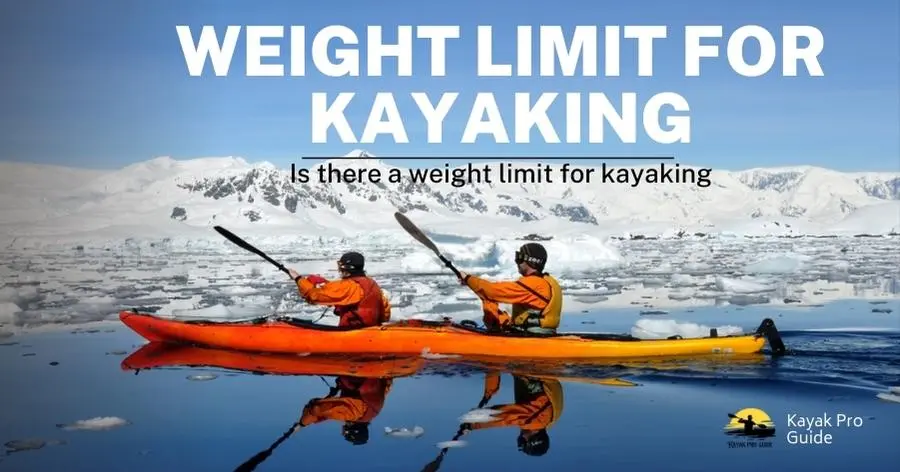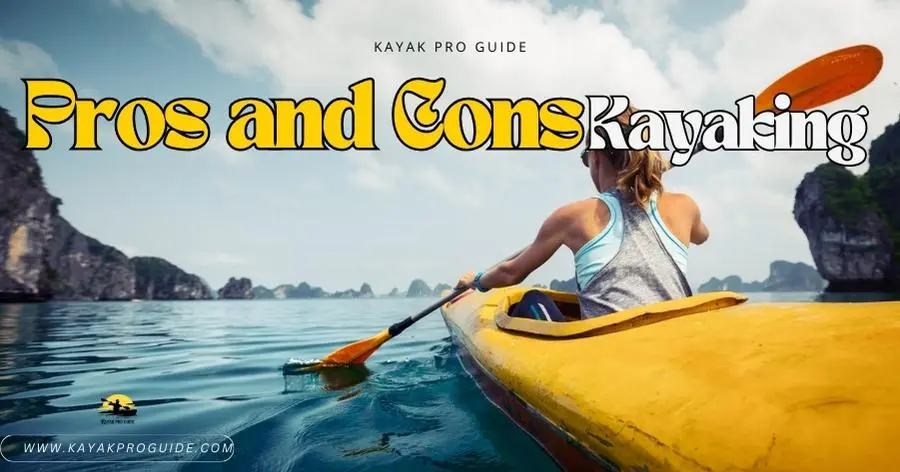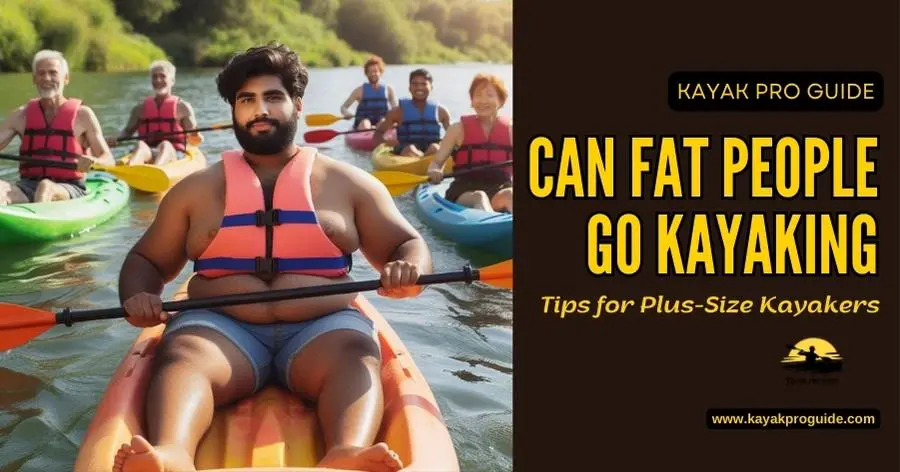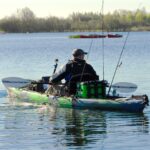At first glance, the question, “Can Fat People Go Kayaking?” might seem ludicrous. After all, kayaking is a sport of balance and endurance – which aren’t often associated with bigger body types. However, this notion can’t be further from the truth!
However, if you’re a plus-size individual, you might have specific concerns or questions about getting started with kayaking. Well, fear not!
In this upcoming blog post, we’ll be diving into the topic of kayaking for plus-size individuals. So, stay tuned for some valuable insights and advice soon!
Can fat people kayak?
The simple answer is yes, absolutely! There’s no specific weight limit for kayaking, and people of all body types can partake in this enjoyable water sport.
Therefore, Kayaks are designed to be stable and buoyant, supporting varying weights without compromising safety or performance.
It’s important to recognize that kayaking can be a fantastic exercise for individuals of all sizes.
Paddling a kayak engages the upper body, core, and legs, providing a full-body workout while being gentle on the joints.
This makes kayaking an excellent choice for those looking to improve their fitness and overall well-being, regardless of size.
More prominent individuals may opt for kayaks designed to accommodate more weight when choosing the right kayak.
However, There are kayaks with higher-weight capacities and wider cockpits that provide ample room and stability for plus-size individuals.
These specially designed kayaks offer extra comfort and support, ensuring a pleasant and secure kayaking experience. So, Safety is paramount in any water-based activity, and kayaking is no exception.
Regardless of their body size, all kayakers should prioritize safety by wearing a properly fitted personal flotation device (PFD) and familiarising themselves with basic water safety practices.
Additionally, taking a kayaking lesson or going out with an experienced guide can provide valuable insights and enhance the overall kayaking experience.
Can an overweight person kayak?
The question is, Can fat people go kayaking? may seem contentious or even offensive to some.
However, it’s a valid query that many heavier individuals are often too embarrassed to ask. This article aims to address this elephant in the room head-on and provide an in-depth answer once and for all.
However, With society constantly pushing fitness boundaries and outdoor activities becoming increasingly popular, more and more people want to venture into the exhilarating world of water sports. Kayaking is no exception; its appeal transcends size, age, or athletic ability.
But can someone who’s overweight paddle their way through a lake or down a river? Let’s dive right into the heart of this matter!
Is kayaking hard on the body?
Kayaking is a fantastic way to get out on the water, enjoy nature, and exercise. However, it’s natural to question how kayaking may affect your body, especially if you’re new to the sport or have specific physical considerations.

In this blog post, I’ll explore the physical demands of kayaking and share tips for beginners and plus-size individuals to enjoy this exciting activity comfortably and safely:
1. The Physical Demands of Kayaking
Can Fat People Go Kayaking? Kayaking is a low-impact activity that offers a full-body workout. So, It engages your arms, shoulders, back, and core muscles, promoting strength and endurance.
The rhythmic paddling also provides a cardiovascular workout, benefiting your heart health and overall fitness.
While kayaking offers numerous physical benefits, it’s essential to understand the potential impact on your body, especially if you have specific concerns related to weight or physical fitness.
2. Addressing Concerns for Plus-Size Individuals
If you’re plus-size and considering kayaking, it’s natural to wonder about the comfort and safety of the activity.
Thus, Rest assured, that individuals of all shapes and sizes can enjoy kayaking. However, there are important considerations to remember to ensure a positive experience on the water.
Tips for Plus-Size Individuals Going Kayaking:
1. Choose the Right Kayak:
Look for kayaks with a broader cockpit and ample weight capacity to accommodate your size comfortably. However, Sit-on-top kayaks are often a great option for plus-size individuals, providing more space and stability.
2. Proper Paddling Technique:
Focus on using your core and legs to power your strokes, minimizing strain on your arms and shoulders. So, Taking a lesson or practicing proper paddling techniques can help prevent undue strain on your body.
3. Gradual Progression:
Start with shorter paddling trips to build your endurance and gradually increase the duration and intensity of your outings. However, This approach allows your body to adapt to the physical demands of kayaking over time.
4. Comfortable Gear:
Thus, Invest in a supportive and comfortable kayak seat to reduce pressure points and enhance paddling comfort. Additionally, wear moisture-wicking clothing to stay dry and comfortable on the water.
5. Listen to Your Body:
Listen to your body’s signals while kayaking. Take breaks as needed, stay hydrated, and be mindful of your energy levels to prevent overexertion.
Enjoying the Benefits of Kayaking
Whether your size or fitness level, kayaking can be rewarding and enjoyable. Therefore, It offers a unique opportunity to connect with nature, explore scenic waterways, and experience the physical and mental benefits of spending time outdoors.
In conclusion, kayaking is a wonderful activity for individuals of all sizes.
However, By understanding the physical demands of kayaking and implementing the tips mentioned above, beginners and plus-size enthusiasts can embark on this adventure with confidence and comfort.
So, grab a paddle, find a beautiful waterway, and get ready to experience the joy of kayaking while caring for your body. Happy paddling!
Is kayaking good for fat loss?
Many people wonder whether kayaking is an effective form of exercise for fat loss. Thus, The answer is a resounding yes!
Kayaking can be an excellent way to help with weight loss, especially if done regularly and with a healthy diet.
Moreover, being out in nature and enjoying the water’s serenity can contribute to overall mental and emotional well-being.
When it comes to fat loss, consistency is key. Thus, Regular kayaking sessions and a balanced diet can contribute to a caloric deficit, essential for losing fat.
The repetitive paddling motion helps ton the arms, shoulders, back, and core muscles. Moreover, It’s a low-impact exercise, making it suitable for individuals of varying fitness levels.
In addition, For those concerned about their weight impacting their ability to kayak, rest assured that kayaking is inclusive and can be enjoyed by individuals of all body types.
On the other hand, Kayaks are designed to accommodate different sizes and shapes, ensuring a comfortable and safe experience.
Whether a beginner or an experienced paddler, the key is to enjoy the process and stay consistent.
Is there a weight limit for kayaking?
Kayaks come in different shapes and sizes, each designed to handle specific weight capacities.
For example, recreational kayaks typically have a higher weight capacity than whitewater kayaks or touring kayaks.
So, It’s crucial to check the manufacturer’s guidelines and specifications for the specific kayak you intend to use.
It’s essential to be mindful of your safety and the overall performance of the kayak. Moreover, overweight kayaks can affect stability and maneuverability, compromising your safety.
However, Overloading the kayak can cause it to sit lower in the water, making paddling more challenging and less enjoyable.

If you’re concerned about weight limits for kayaking, here are a few tips to keep in mind:
1. Check the manufacturer’s guidelines:
Review the specifications provided by the kayak manufacturer to determine the kayak’s weight capacity.
2. Consider your weight and gear:
Consider your weight and any additional gear, supplies, or equipment you plan to bring along on your kayaking adventure.
3. Choose the right kayak:
Select a kayak suitable for your body weight and intended use. Similarly, Recreational kayaks, sit-on-top kayaks, and inflatable kayaks are often more forgiving regarding weight capacity.
4. Seek expert advice:
Thus, If you’re unsure about which kayak to choose or have concerns about weight limits, consider seeking advice from experienced kayakers or professionals at a reputable outdoor gear store.
Ultimately, while there may be weight limits for kayaking, it’s more about finding the right kayak that suits your body weight and intended use.
So, Individuals of varying body weights can enjoy the wonderful kayaking experience with the appropriate kayak and safety precautions.
Tips for Plus-Size Kayakers
Well, the good news is that kayaking is an activity that people of all shapes and sizes can enjoy!
In this blog, I’ll explore the world of kayaking for plus-size individuals and provide you with essential tips to ensure a fantastic experience on the water:
1. Choosing the Right Kayak:
When it comes to kayaking as a plus-size individual, selecting the right kayak is crucial. Look for kayaks with a higher weight capacity to ensure stability and also safety on the water. Opt for wider kayaks with ample legroom to provide comfort and support.
2. Proper Gear and Clothing:
Wearing the right gear and clothing can significantly impact your kayaking experience. Therefore, Invest in a comfortable, well-fitting life jacket that provides adequate buoyancy.
Moreover, choose moisture-wicking clothing that allows for freedom of movement and keeps you dry and comfortable throughout your kayaking adventure.
3. Technique and Paddling:
Learning proper paddling techniques is essential for an enjoyable kayaking experience. So, take the time to understand the basics of paddling, including proper grip, posture, and stroke technique. Practice in calm waters before venturing into more challenging conditions.
4. Finding the Right Location:
When planning your kayaking adventure, consider the location carefully. Look for calm, flat waters or slow-moving rivers that offer a gentle and serene paddling experience.
Avoid areas with strong currents or challenging conditions until you feel confident in your kayaking abilities.
5. Partner Up or Join a Group:
Kayaking with a partner or joining a group can enhance your experience and provide security, especially if you’re new to the activity. Sharing the adventure with others can also create memorable experiences and foster a sense of camaraderie.
6. Safety First:
Prioritise safety at all times when kayaking. Thus, Be mindful of weather conditions, stay aware of your surroundings, and follow all safety guidelines and regulations. Always carry essential safety equipment, such as a whistle and a first aid kit, and be prepared for unexpected situations.
7. Embrace the Experience:
Above all, embrace the experience of kayaking as a plus-size individual. However, Focus on the joy of being on the water, surrounded by nature, and relish the sense of freedom that kayaking provides.
So, take in the sights, sounds, and sensations of the natural world as you paddle along. In conclusion, kayaking is an exhilarating and accessible activity for individuals of all sizes, including plus-size individuals.
Following these tips and embracing the adventure, you can enjoy a fantastic kayaking experience that brings joy, serenity, and a deeper connection to the great outdoors.
So, can plus-size people go kayaking? Absolutely! With the proper preparation, mindset, and determination, kayaking can be a fulfilling and enjoyable activity for everyone, regardless of size.

Pros and Cons of Fat People Go Kayaking
A. Pros:
| Aspect | Benefits |
| Accessibility | Low-impact exercise suitable for various fitness levels |
| Physical and Mental Health | Improves fitness, reduces stress, strengthens muscles |
| Outdoor Experience | Enjoys nature, explores waterways, reduces anxiety |
| Community | Welcoming and supportive atmosphere, access to resources |
| Versatility | Choose calm waters, coastal adventures, diverse styles |
B. Cons:
| Aspect | Challenges to Consider |
| Finding Equipment | Limited options for kayaks specifically designed for larger body types |
| Entry and Exit | Getting in and out of kayaks can be more difficult |
| Physical Limitations | Dress appropriately and choose routes based on water conditions and temperature. |
| Weather Awareness | Dress appropriately and choose routes based on water conditions and temperature |
C. Tips for Plus-Size Kayakers:
1. Prioritize Comfort
Thus, Choose kayaks with wide cockpits, comfortable seats, and adequate legroom. So, Consider adding padding or back support if needed.
2. Invest in Lessons
A qualified instructor can teach proper paddling techniques, safety procedures, and confidence-building skills.
3. Safety First
Always wear a life jacket and dress appropriately for the water temperature and weather conditions. So, Choose routes that match your physical capabilities.
4. Seek Support
Don’t hesitate to ask for help launching, landing, or carrying your kayak. Community support is invaluable.
5. Personalize the Experience
So, Explore different kayak styles, paddles, and accessories to find what works best for you.
Remember:
Kayaking is a fantastic activity for everyone, regardless of size. Moreover, With careful planning, proper equipment, and a focus on safety, you can have a safe and enjoyable paddling experience.
Related Post
How To Inflate An Inflatable Kayak
Can You Put A Pedal Drive On Any Kayak
How To Protect Phone While Kayaking
Can You Paint A Kayak
How To Make A Kayak More Comfortable
Final Note of Can Fat People Go Kayaking
At last, I think it is clear to my audience that Fat People Can Go Kayaking.
Furthermore, With the right equipment, techniques, and mindset, people with larger bodies can fully enjoy the benefits of kayaking.
Basically, using a well-fitted life jacket is crucial to invest in a suitable kayak with a higher weight capacity.
Therefore, practicing proper paddling techniques ensures a safe and enjoyable experience on the water.
Moreover, seeking guidance from experienced kayakers or instructors can provide valuable tips and support.
Thus, with the proper preparation and a positive attitude, individuals of all sizes can embrace the kayaking adventure and reap the physical and mental rewards it offers.













1 thought on “Can Fat People Go Kayaking | Tips for Plus-Size Kayakers”